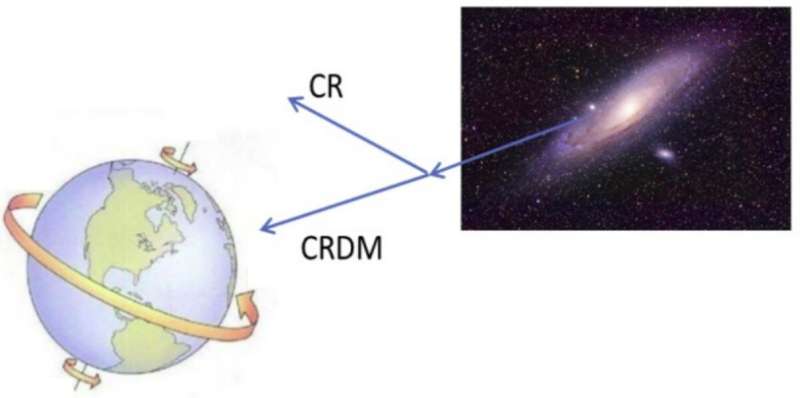March 29, 2021 feature
Study identifies a new type of diurnal effect for cosmic ray-boosted dark matter

Over the past few decades, astrophysicists and cosmologists have gathered various observations hinting at the existence of dark matter (DM), a type of matter that does not absorb, reflect or emit light, and thus cannot be detected using conventional techniques for observing electromagnetic radiation. While physicists have predicted its existence based on astrophysical and cosmological observations, so far, DM has never been observed experimentally.
The most sensitive mass window for experiments aimed at directly detecting DM with conventional technologies (i.e., searching for nuclear recoils in detectors) is O(10-100)GeV. When it comes to light DM, particularly that in the sub-GeV range, the scattering of DM with nuclei cannot produce a nuclear recoil above the threshold at which it would be detected by existing technologies.
Researchers at Shanghai Jiao Tong University and the Purple Mountain Observatory of the Chinese Academy of Sciences have been trying to identify strategies that could help to overcome this challenge and unveil characteristic signals of sub-GeV DM with a wider sensitivity range (i.e., that would be easier to detect). One of their most recent papers, published in Physical Review Letters, delineates a new type of diurnal effect relevant to sub-GeV DM boosted by cosmic rays. This effect could potentially enable the direct detection of sub-GeV DM with nuclear recoils.
"It was pointed out in the literature that as long as DM can interact with nuclei, the energetic nuclei in the space (cosmic rays) can -accelerate some DM particles to higher energy to overcome the detection threshold, naturally opening up the low-mass window," Shao-Feng Ge and Qiang Yuan, two of the researchers who carried out the study, told Phys.org. "We went further on this by noticing that both DM and cosmic rays have high density around the galaxy center (GC)."
In the scenario considered by Ge, Yuan and their colleagues, accelerated DM particles would primarily come from the direction of the GC, which provides a unique feature distinct from the ordinary component of DM. While detection techniques based on the analysis of nuclear recoil cannot unveil what direction DM particles would be coming from, when the GC is located on the opposite side of Earth from where the detector is, the Earth could shadow a large portion of accelerated DM.
In other words, the researchers found that if DM nuclei scattering cross sections are sufficiently large, the flux of DM is attenuated as it propagates through Earth. This leads to a natural diurnal modulation, which could serve as a characteristic signature of accelerated DM.
"The conventional diurnal effect is only for slow moving (nonrelativistic) DM particles in our galaxy (so-called standard DM halo)," Ge and Yuan said. "The effect is negligibly small either from direct experimental constraints, or due to the detection threshold. For light DM particles, on the other hand, the DM-nucleus interaction is much less constrained, which leaves room for strong diurnal modulation."
In their paper, the researchers show that cosmic ray acceleration could enable or facilitate the detection of DM particles. In addition, they suggest that the unique diurnal modulation behavior they described is characterized by a directional and higher energy flux.
"The diurnal modulation signature proposed in our study could be a smoking gun of cosmic ray boosted dark matter detection, while the dominant background from radioactive impurities does not have this feature," Ning Zhou and Jianglai Liu, two researchers involved in the study, told Phys.org. "The nuclear recoil energy spectrum would also exhibit a daily modulation, which could be a further means to suppress potential background."
Remarkably, this study identified a new signature associated with cosmic ray boosted DM. In the future, this research group and other teams could analyze data gathered in past, ongoing and future underground DM experiments, specifically searching for the unique diurnal modulation signature highlighted in the recent paper.
"We will now encourage experimenters worldwide to perform a careful search for this signature in their data," Zhou and Ge said. "More on the theoretical side, in our paper the model of the earth attenuation is treated with a simplified model, which we plan to improve. We will also try to determine whether there is an ideal combination of multiple underground experiments which could further signify the detection."
More information: Diurnal effect of Sub-GeV dark matter boosted by cosmic rays. Physical Review Letters(2021). DOI: 10.1103/PhysRevLett.126.091804.
Journal information: Physical Review Letters
© 2021 Science X Network





















